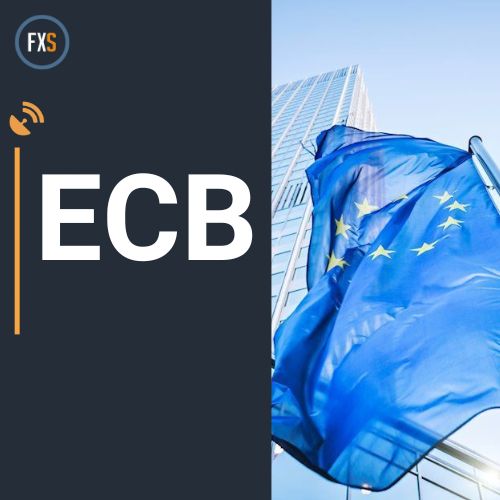ECB Press Conference: Lagarde comments on outlook after cutting interest rates by 25 bps

Christine Lagarde, President of the European Central Bank (ECB), explains the ECB's decision to lower the benchmark interest rate by 25 basis points at the December policy meeting and responds to questions from the press.
ECB press conference key highlights
"Growth is losing momentum, firms are holding back investment."
"Surveys point to fewer jobs being created."
"Recovery is slower than expected."
"Exports should support recovery if trade tensions don't escalate."
"Risks to growth are tilted to downside."
"Trade friction could weigh on growth."
"Wages, profits, geopolitics are among upside risks to inflation."
"Downside risks to inflation include low confidence, geopolitical stress, low investment."
"Macroprudential policy remains the first line of defense against the build-up of financial vulnerabilities."
"No victory yet against inflation."
"There were some discussion about a 50 bps cut."
"Observing decline in profit margins."
"Productivity is more promising."
"Risk to inflation is now two-sided."
"I don't think about market pricing of rate hikes."
"We have not discussed neutral rate level in this meeting."
"Protectionism is inflationary in the short term."
This section below was published at 13:15 GMT to cover the European Central Bank's (ECB) monetary policy announcements and the immediate market reaction.
The European Central Bank (ECB) announced on Thursday that it lowered key rates by 25 basis points (bps) following the December policy meeting, as expected. With this decision, the interest rate on the main refinancing operations, the interest rates on the marginal lending facility and the deposit facility stood at 3.15%, 3.4% and 3%, respectively.
In its policy statement, the ECB noted that most measures of underlying inflation suggest that inflation will settle at around the Governing Council's 2% medium-target on a sustained basis.
Follow our live coverage of the ECB policy announcements and the market reaction.
ECB policy statement key highlights
"Financing conditions are easing but they continue to be tight because monetary policy remains restrictive and past interest rate hikes are still transmitting to the outstanding stock of credit."
"Will follow a data-dependent and meeting-by-meeting approach to determining the appropriate monetary policy stance."
"The Governing Council is not pre-committing to a particular rate path."
"Decision to lower the deposit facility rate is based on its updated assessment of the inflation outlook, the dynamics of underlying inflation and the strength of monetary policy transmission."
"Determined to ensure that inflation stabilizes sustainably at its 2% medium-term target."
"Domestic inflation has edged down but remains high."
"APP and Pandemic Emergency Purchase Programme (PEPP) APP portfolio is declining at a measured and predictable pace, as Eurosystem no longer reinvests principal payments from maturing securities."
"Eurosystem no longer reinvests all of principal payments from maturing securities purchased under PEPP, reducing PEPP portfolio by €7.5 billion per month on average."
"ECB will discontinue reinvestments under PEPP at end of 2024."
"ECB's new growth forecast: 0.7% in 2024, 1.1% in 2025, 1.4% in 2026 and 1.3% in 2027."
"ECB's new inflation forecast: 2.4% in 2024, 2.1% in 2025, 1.9% in 2026 and 2.1% in 2027."
"ECB's new core inflation forecast: 2.9% in 2024, 2.3% in 2025 and 1.9% in both 2026 and 2027."
Market reaction to the ECB policy announcements
The Euro stays under modest bearish pressure following the ECB announcements. At the time of press, EUR/USD was down 0.15% on the day at 1.0480.
Euro PRICE This week
The table below shows the percentage change of Euro (EUR) against listed major currencies this week. Euro was the weakest against the US Dollar.
| USD | EUR | GBP | JPY | CAD | AUD | NZD | CHF | |
|---|---|---|---|---|---|---|---|---|
| USD | 0.80% | 0.14% | 1.60% | 0.11% | -0.05% | 0.89% | 1.16% | |
| EUR | -0.80% | -0.65% | 0.89% | -0.60% | -0.76% | 0.17% | 0.44% | |
| GBP | -0.14% | 0.65% | 1.40% | 0.01% | -0.11% | 0.83% | 1.09% | |
| JPY | -1.60% | -0.89% | -1.40% | -1.49% | -1.54% | -0.82% | -0.36% | |
| CAD | -0.11% | 0.60% | -0.01% | 1.49% | -0.11% | 0.77% | 1.04% | |
| AUD | 0.05% | 0.76% | 0.11% | 1.54% | 0.11% | 0.94% | 1.21% | |
| NZD | -0.89% | -0.17% | -0.83% | 0.82% | -0.77% | -0.94% | 0.25% | |
| CHF | -1.16% | -0.44% | -1.09% | 0.36% | -1.04% | -1.21% | -0.25% |
The heat map shows percentage changes of major currencies against each other. The base currency is picked from the left column, while the quote currency is picked from the top row. For example, if you pick the Euro from the left column and move along the horizontal line to the US Dollar, the percentage change displayed in the box will represent EUR (base)/USD (quote).
This section below was published as a preview of the European Central Bank's policy announcements at 08:00 GMT.
- The European Central Bank is expected to cut benchmark interest rates by 25 bps at the December policy meeting.
- ECB President Christine Lagarde’s presser will be closely scrutinized for fresh policy cues.
- The ECB policy announcements are set to ramp up the Euro’s volatility.
The European Central Bank (ECB) interest rate decision will be announced following the December monetary policy meeting at 13:15 GMT on Thursday.
ECB President Christine Lagarde's press conference will follow, beginning at 13:45 GMT, where she will deliver the prepared statement on monetary policy and respond to media questions. The ECB announcements are likely to drive the Euro’s (EUR) valuation in the second half of the week.
What to expect from the European Central Bank interest rate decision?
Following the October policy meeting, the ECB announced that it lowered key rates by 25 basis points (bps). With this decision, the interest rate on the main refinancing operations, the interest rates on the marginal lending facility and the deposit facility, also known as the benchmark interest rate, stood at 3.4%, 3.65% and 3.25%, respectively.
The ECB is widely expected to lower key rates by another 25 bps after the December meeting.
In the post-meeting press conference in October, President Lagarde said that the ECB policy was still restrictive and noted that they are concerned about the growth outlook. Although she refrained from clearly stating whether they would opt for another policy-easing step at the last meeting of the year, markets widely expect the ECB to lower key rates by 25 bps.
Commenting on the policy outlook, ECB policymaker Joachim Nagel noted that he would have no objections to reducing the policy rate, given that the disinflation process is proceeding largely as currently projected. On a similar note, Governing Council member Francois Villeroy de Galhau said: “There is every reason to cut on December 12th.” “Optionality should remain open on the size of the cut, depending on incoming data, economic projections and our risk assessment,” he added.
Assessing the EUR’s positioning in the Commitment of Traders report (COT), “EUR net short positions have increased for the third consecutive week, driven by an increase in short positions,” Rabobank analysts said. They added: “EUR was the worst performing G10 currency in the month of November, depreciating 2.37% against USD. EUR has suffered from deteriorating economic fundamentals and impending cuts from the ECB. We expect the ECB to cut the policy rate 25bp at the December 12th.”
How could the ECB meeting impact EUR/USD?
In November, EUR/USD lost nearly 3%. In addition to the negative impact of the ECB’s dovish policy outlook on the EUR, the broad-based US Dollar (USD) strength following Donald Trump’s victory in the US presidential election weighed heavily on EUR/USD. Since the beginning of December, EUR/USD has been fluctuating in a relatively tight range, reflecting investors’ hesitancy to take large positions ahead of the ECB and the Federal Reserve’s (Fed) final meetings of 2024.
In case the ECB unexpectedly lowers key rates by 50 bps, the immediate reaction could trigger a Euro selloff and open the door for another leg lower in EUR/USD. If the ECB opts for a 25 bps cut but Lagarde voices concerns over the economic situation in the Eurozone and mentions growing downside risks to inflation, EUR/USD is likely to extend its downtrend, even if the immediate market reaction is mixed.
In this current market environment, the Euro would need a significant hawkish surprise to stage a steady recovery against the USD. If Lagarde adopts a more optimistic tone about the economic outlook and highlights the need for patience in further policy easing, EUR/USD could gain traction in the near term.
Eren Sengezer, European Session Lead Analyst at FXStreet, offers a brief technical outlook for EUR/USD:
“Following the modest rebound seen in December, EUR/USD’s near-term technical outlook points to a loss of bullish momentum. On the daily chart, the Relative Strength Index edges higher toward 50 and the pair manages to hold above the 20-day Simple Moving Average (SMA).”
“On the upside, the Fibonacci 38.2% retracement of the October–December downtrend aligns as the next resistance at 1.0700 before 1.0800 (Fibonacci 50% retracement) and 1.0840 (200-day SMA). In case EUR/USD flips 1.0530 (20-day SMA) into resistance, technical sellers could continue to dominate the pair’s action. In this scenario, 1.0400 (end-point of the downtrend) could be seen as the next support before 1.0260 (static level).”
ECB FAQs
The European Central Bank (ECB) in Frankfurt, Germany, is the reserve bank for the Eurozone. The ECB sets interest rates and manages monetary policy for the region. The ECB primary mandate is to maintain price stability, which means keeping inflation at around 2%. Its primary tool for achieving this is by raising or lowering interest rates. Relatively high interest rates will usually result in a stronger Euro and vice versa. The ECB Governing Council makes monetary policy decisions at meetings held eight times a year. Decisions are made by heads of the Eurozone national banks and six permanent members, including the President of the ECB, Christine Lagarde.
In extreme situations, the European Central Bank can enact a policy tool called Quantitative Easing. QE is the process by which the ECB prints Euros and uses them to buy assets – usually government or corporate bonds – from banks and other financial institutions. QE usually results in a weaker Euro. QE is a last resort when simply lowering interest rates is unlikely to achieve the objective of price stability. The ECB used it during the Great Financial Crisis in 2009-11, in 2015 when inflation remained stubbornly low, as well as during the covid pandemic.
Quantitative tightening (QT) is the reverse of QE. It is undertaken after QE when an economic recovery is underway and inflation starts rising. Whilst in QE the European Central Bank (ECB) purchases government and corporate bonds from financial institutions to provide them with liquidity, in QT the ECB stops buying more bonds, and stops reinvesting the principal maturing on the bonds it already holds. It is usually positive (or bullish) for the Euro.
Author

FXStreet Team
FXStreet

















